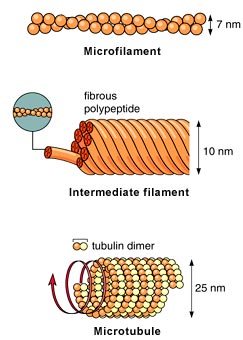Filaments
Filaments Assignment Help | Filaments Homework Help
Filaments
Microfilaments are 50 to 70A in diameter and are found in clusters beneath the cell membrane. A microfilament is a single strand of identical globular proteins which are very similar to, or may be identical with, actin of muscles. Microfilaments are arranged in two different ways. In one arrangement they lie in parallel bundles near the surface of cell membrane, e.g., in the cleavage furrow of dividing cells and in glial cells. The bundles also contain other muscle proteins like myosin, tropomyosin and α-actinin in cultured cells like chicken fibroblasts.In the other type of arrangement the microfilaments occur as a loose meshwork, e.g. in actively moving regions of cells like the pseudopodia of Amoeba aud rat embryo fibroblasts.
Neurofilaments. Nerve cells possess microfilaments, larger filaments called neurofilaments and microtubules. Neurofilaments have a diameter of about 100A and travel along the length of most axons. Under the electron the microscope they appear tetragonal in transverse sections, and have an unstained central channel. The major protein component of neurofilaments has a molecular weight of 70,000. This along with its amino acid composition and immunological reaction indicates that it is not tubulin or actin. It is possible that the neurofilaments function in the transport of material from their sites of synthesis in the cyton to the end of the axon. Two types of transport mechanism have been observed, slow transport involving soluble and particulate components and fast transport (about 100mm per day) carrying organelles and particles. The microtubules also appear to be involved in these movements.

For more help in Filaments please click the button below to submit your homework assignment.